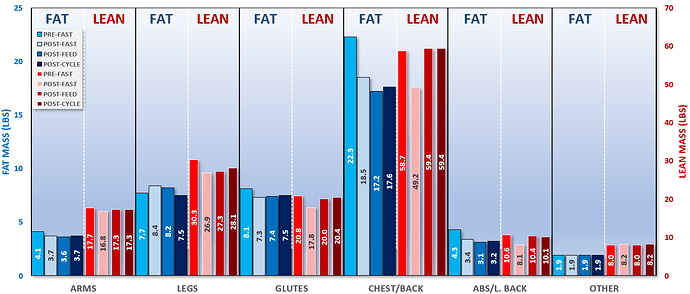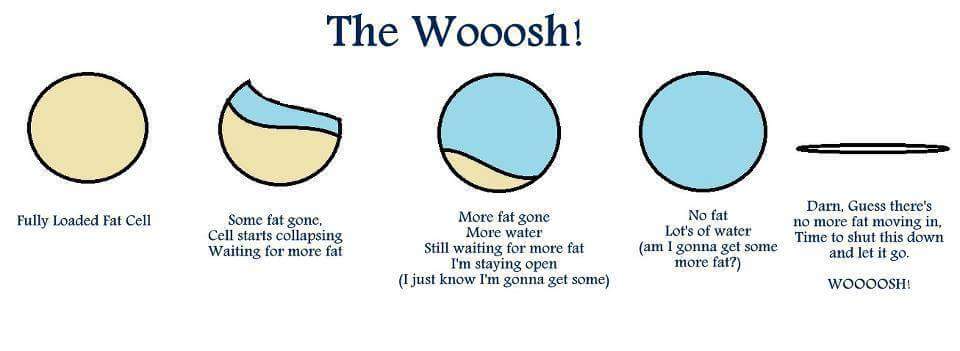You documented individual fat cells being removed? How?
What happens to those fat cells?
No… I measured overall lean mass and fat mass loss via DEXA
I expect that the fat cells (protein sacs) would actually be “lean mass” when empty.
No. But autophagy reduces all under utilized, disfunctional, or aging cells. I can’t measure it directly but if my body decides to remove lean muscle from my glutes and legs, it stands to reason that unused fat cells are equally as disposable?
There must be a guiding mechanism for autiphagy… and the regeneration that comes after it. The muscle regen is based on demand - exercise. The fat cell regen should be a function of demand for storage?
it’s a hypothesis, but not a conclusion really. Can’t know. It’s also logical that some things are not autophaged
so this is interesting: Our data suggest that activation of AT autophagy protects against adipocyte apoptosis at least under conditions of obesity related MetS in WOKW rats.
so autophagy results in healthier fat cells that don’t die off?
Our data showed that ghrelin, a gut-derived hormone involved in the regulation of energy balance, operates as a negative regulator of tumor necrosis factor α (TNF-α)-induced apoptosis and autophagy in visceral adipocytes. The imbalance between ghrelin and TNF-α in states of insulin resistance may contribute to the altered apoptosis and autophagy found in adipose tissue of patients with type 2 diabetes. A better understanding of the pathways involved in programmed cell death in adipose tissue is needed for fully disentangling the etiopathology of obesity-associated type 2 diabetes.
Fat cells give you somewhere to safely store fat - I can’t imagine why you’d want to reduce their number.
The average life of an adipocyte is about 10 years, if I recall correctly, so there is always at least a small amount of turnover. It used to be the thinking that fat cells never reduced their numbers, and that is certainly a plausible notion. It would make a great deal of evolutionary sense for the body hang onto a certain minimum of fat cells, given the role that adipose tissue is supposed to play as the flywheel of the metabolism (in healthy people, at least). The adipose tissue is supposed to be constantly storing energy as it comes in during meals, and then doling it out again between meals, especially during the overnight fast.
There actually may be an advantage to having the ability, as some people do, to make more fat cells. It is hypothesized that the people who develop metabolic disease are the ones who cannot make more adipocytes, because as they fill up with fat, they become insulin-resistant. It is believed that by contrast, the people who can make more adipocytes are the 20% of obese people who remain metabolically healthy.
Science was just above your comments? 
What happens to those fat cells?
Adiposite apoptosis does happen
The body recycles and adapts to be as efficient as it can be - my own n=1 was a loss of 4lbs of lean muscle in my legs over 19 days of continuous fasting… if you can imagine what 4lbs of steak - that’s what it decided was disposable over less than three weeks.
I worked out every other muscle group except for legs, and that’s exactly where my body decided to eliminate “unnecessary” material.
Why/if empty fat cells would be more valuable than muscle so that none of them would be broken down while being unused would be interesting.
But the articles I cited refer to both adiposite autophagy and apoptosis as being common functions.
Is it possible that junk lean mass or muscle is recycled because the body needs protein and that fat cell numbers are maintained because the body needs somewhere safe to store fat?
I don’t know.
If I’m rapidly losing fat and my fat cells are unused for weeks at a time, is it a better economy to keep those fat cells?
But to your point, I was weightlifting nearly daily and maybe that created a demand elsewhere and the body went to the one part I wasn’t pushing for the protein construction material. I wouldn’t call it “junk lean mass”  but less demand was placed on it compared to other lean mass construction.
but less demand was placed on it compared to other lean mass construction.
Unfortunately, there was no net growth in other areas. The most I managed to do was hold on to what I had. Look at the first red bar for each body part and the third red bar. Those are the pre-fast and post-feed. Legs went from 30.3 to 27.3 and Glutes went from 20.8 to 20.0…
Gained 0.3 in chest and back with a few more lost here and there.
The scientific literature says that we need to understand the drivers - so clearly they don’t know for sure either.
I would imagine the answer to be yes. When times are good (food is more plentiful) you will want somewhere safe to store the excess calories to carry you through leaner times.
Had you worked your legs during your experiment I’m guessing you would not have lost so much lean mass - the other recycled proteins would have been put to work.
I can’t argue with what might have happened… so maybe. 
I do wonder where that would have come from. My hope was that it would come from my loose skin (older skin doesn’t stretch back so well) or unnecessary adipose cell membranes… Unfortunately, my loose skin did not get much better on my extended fast. I can’t quantify the fat cell reduction. The highest resolution I could get from DEXA was the 5 parts above + other.
Actually… since the adipose cells would have been characterized as lean mass when empty…it is possible that the loss in my thighs WAS empty adipose. I never considered this because I assumed that the lean mass in my legs would have been muscle!!
I carried most of my weight in my thighs and belly. My legs got much slimmer and more tone, but I attributed that to the loss of fat (lipid) there, without much consideration for the empty adiposite cells.
wow - that’s an interesting possibility!
Visceral adiposity is much different than subcutaneous fat cells; it only takes 48 hours of fasting to reduce the visceral fat around the internal organs by 25%? (…and inside the internal organs as well) That’s why Dr. Jason Fung is a genius!
That’s pretty dam fast compared to the subcutaneous fat cells willingness to give up the lipid droplets?
If we had any idea of how fast that is? It would be the equivalent of doing a ketogenic diet for 6 months at three meals per day to possibly reverse diabetes!
Geez, put that way, I imagine it’s a great way to kick off LCHF/keto and speed the visceral fat change so as to access the subcutaneous more quickly? For those who have the lifestyle/schedule that allows them to fast, rest, and do all they need to do.
So, the letting go of the watery fluid only means death of a fat cell after it’s reached its 10 year mark - or at a rate of 8% according to above posts.
Otherwise, fat cells just collapse and become skinny?
Well, for those of us who can’t embark on 48 hour fasts though, it becomes the main, slow route for fat loss/recomposition before maintenance. I guess fasting is the fast lane!



